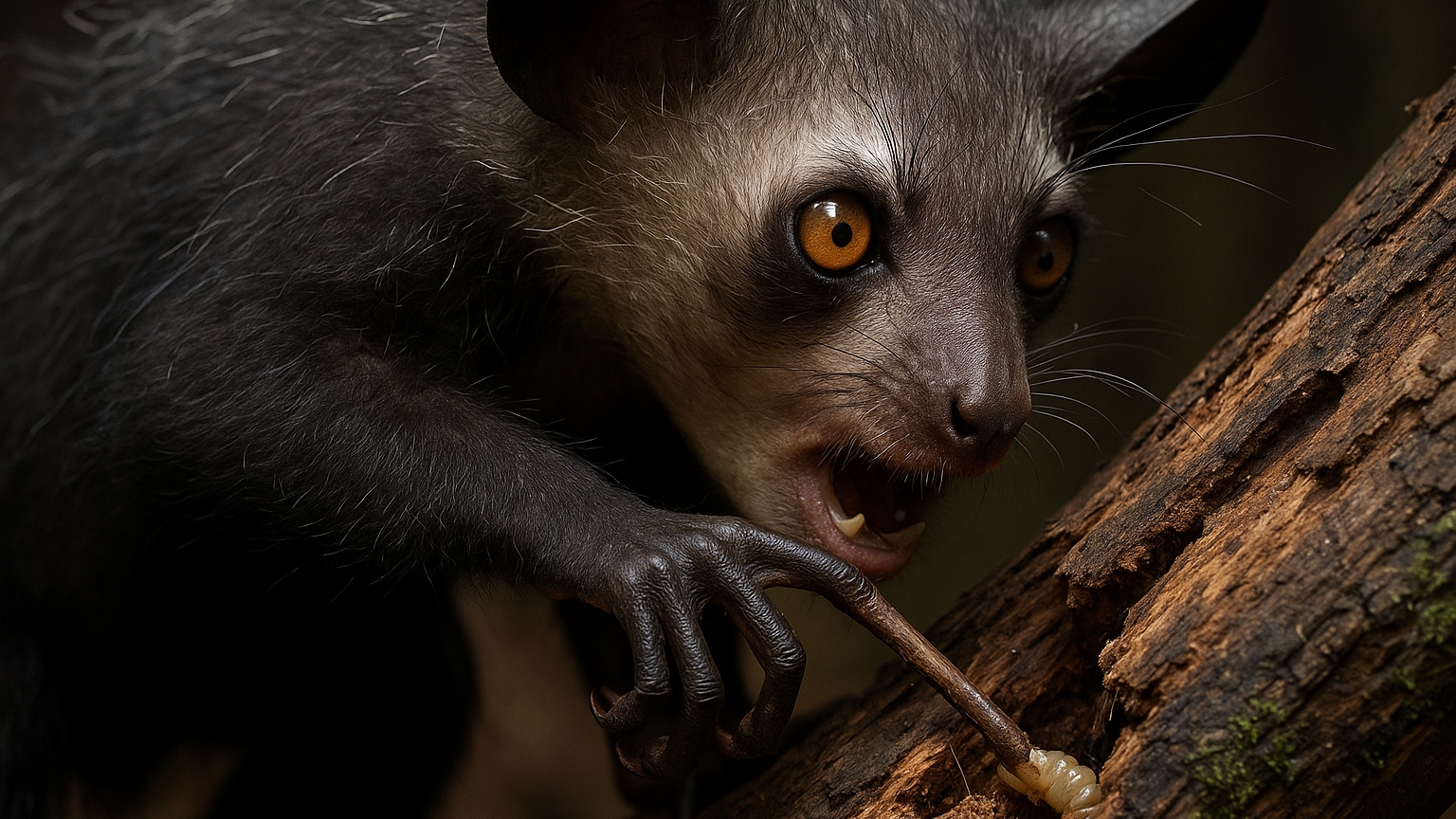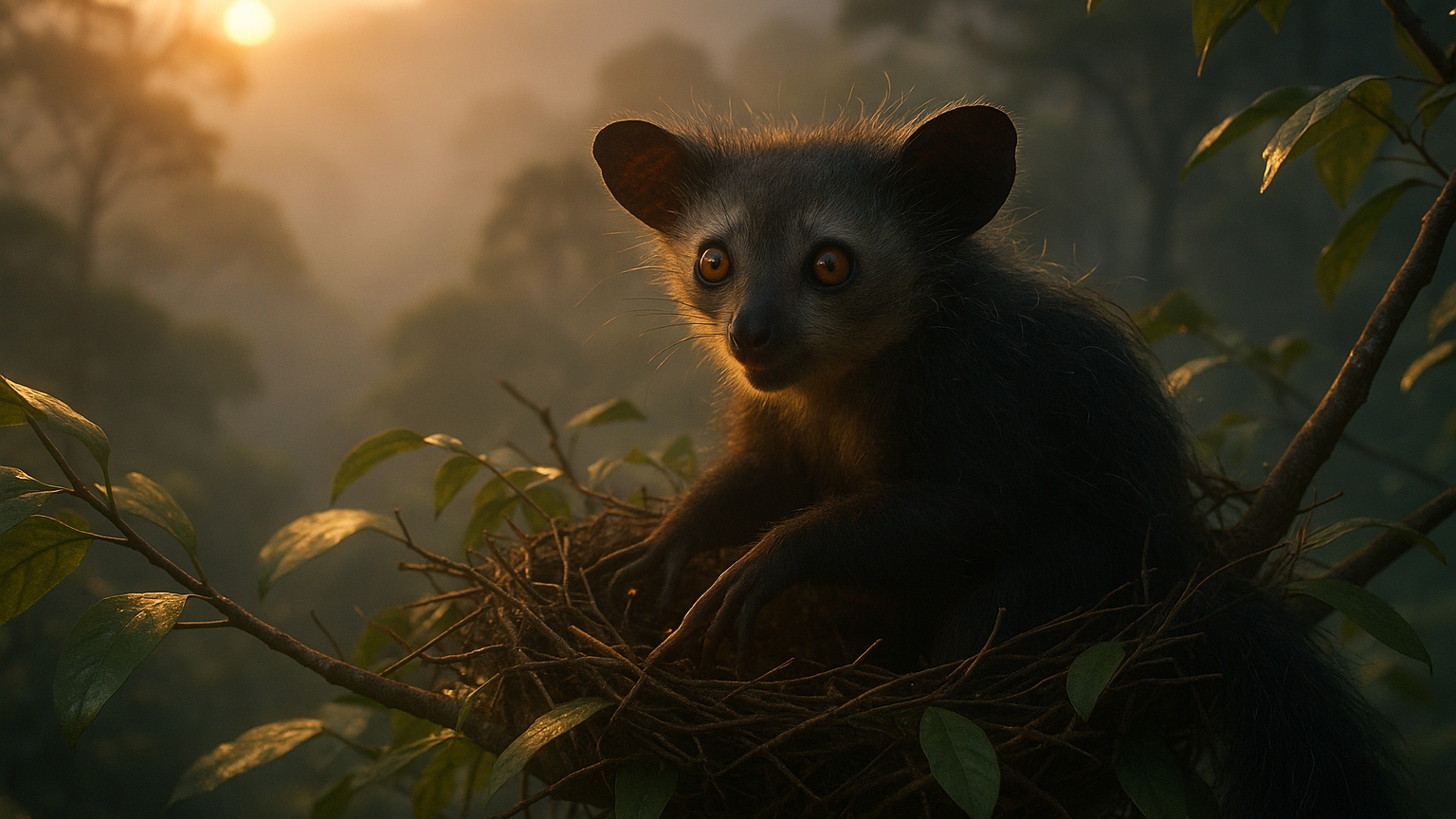The Aye-aye: Madagascar’s Most Mysterious Primate
Deep within the rainforests of Madagascar lives one of the world’s most unusual and captivating creatures: the Aye-aye (Daubentonia madagascariensis). With its oversized ears, luminous eyes, bushy tail, and signature skeletal middle finger, the Aye-aye defies expectation and classification. To some, it resembles a gremlin; to scientists, it is a marvel of evolutionary adaptation. Long misunderstood and shrouded in myth, this nocturnal lemur continues to enchant biologists, conservationists, and curious minds alike.
The Aye-aye is not only unique in appearance but also in behavior, feeding methods, and evolutionary history. As the only surviving member of the family Daubentoniidae, the Aye-aye occupies a special place in the primate lineage, offering key insights into adaptation and survival in island ecosystems. Despite its bizarre looks and elusive habits, the Aye-aye is a vital part of Madagascar’s biodiversity and a symbol of the island’s unparalleled natural heritage.
Origins and Evolution: A Peculiar Place in Primate History
The Aye-aye is a lemur, but it differs so drastically from its relatives that early naturalists believed it might be a rodent or marsupial. Its rodent-like teeth, which grow continuously throughout life, along with its long, clawed fingers and omnivorous diet, led to considerable taxonomic confusion. Ultimately, it was placed within the primate order, but in its own distinct family—Daubentoniidae.
Fossil evidence suggests that the Aye-aye once had a more widespread lineage in Madagascar. Extinct relatives, such as Daubentonia robusta, were significantly larger. Today, however, Daubentonia madagascariensis stands alone, a living fossil of sorts, showcasing how unique environmental pressures on Madagascar have shaped such specialized life forms.
Distinctive Features: What Makes an Aye-aye an Aye-aye?
Nothing about the Aye-aye is ordinary. Its shaggy dark fur, large bat-like ears, and bushy tail that rivals its body in length give it an otherworldly look. But its most famous feature is undoubtedly the elongated third finger of its hand. This finger is thin, bony, and highly flexible—perfectly evolved for a particular feeding technique known as percussive foraging.
The Aye-aye’s middle finger is akin to a natural tool, which it uses to tap along tree trunks and branches, listening for the hollow echoes that indicate the presence of wood-boring insect larvae. Once a likely meal is located, the Aye-aye gnaws through the bark with its continuously growing incisors—similar to those of rodents—and inserts its finger into the tunnel to extract the grub. This method, often likened to that of a woodpecker, is unparalleled among primates.
In addition to its insect-hunting prowess, the Aye-aye uses its sensitive finger to scoop out the gelatinous flesh of coconuts and the sweet pulp of fruits. It has also been observed using its middle digit to groom itself, retrieve small items, and even drink water from narrow crevices. This multipurpose appendage is a key to the species’ survival and one of nature’s most fascinating evolutionary inventions.
Nightlife in the Rainforest: Behavior and Activity
As a strictly nocturnal animal, the Aye-aye emerges after sunset to begin its nightly foraging. It typically ranges widely in search of food, covering several kilometers each night. Despite its lumbering appearance, it moves nimbly through the canopy using its strong limbs and bushy tail for balance. The Aye-aye’s large ears allow it to detect even the faintest sounds of insect movement within wood, while its large eyes are adapted for low-light vision.
It tends to be solitary, with individuals maintaining overlapping home ranges but avoiding direct contact except during mating or, occasionally, when mothers rear their young. When an Aye-aye sleeps, it curls up inside a leafy nest high in the trees, typically constructed in the fork of branches and hidden from predators. These nests are used repeatedly and may even serve as territorial markers. Nest building is an art in itself, requiring carefully woven leaves and twigs and offering a glimpse into the animal’s cognitive abilities.

Diet and Foraging: A Lemur Like No Other
The Aye-aye’s diet is as unusual as its anatomy. It is an omnivore, consuming a mix of insect larvae, fruits, seeds, nectar, fungi, and even small vertebrates. However, its specialized foraging behavior makes it one of the only primates to fill the ecological niche of a woodpecker. Aye-ayes are especially fond of canarium nuts, coconuts, and other tough-shelled fruits. Their powerful incisors make short work of these, and their nimble fingers probe for every edible morsel.
Researchers have documented individuals foraging for up to six hours in a single night, displaying a level of determination and skill that is rare among tree-dwelling primates. Interestingly, Aye-ayes will sometimes exhibit what appears to be food caching—saving hard-to-access items like coconuts for future meals. While not yet fully understood, this behavior may point to a degree of foresight not often attributed to lemurs, adding yet another layer of intrigue to this enigmatic species.
Reproduction and Lifespan: Mysterious Beginnings
Aye-ayes are slow to reproduce, a characteristic that makes them particularly vulnerable to population decline. Mating can occur at any time of year, though peaks are observed during specific seasons depending on the region. Males often engage in vocal disputes or brief chases when competing for a receptive female, but physical confrontations are rare. The gestation period lasts approximately 170 days, after which a single infant is born, usually inside a secure nesting site.
The newborn is altricial—born helpless and dependent—requiring intense maternal care. The mother nurses the infant for several months, and the youngster may remain with her for up to two years, learning to forage and survive in the dense canopy. In captivity, Aye-ayes can live for over 20 years, and wild individuals are believed to have similar lifespans, though data remains limited due to their elusive nature. Their slow reproductive rate combined with their long maturation period makes each individual critical for the population’s long-term stability.
Habitat and Range: Life on the Edge of the Forest
Native exclusively to Madagascar, Aye-ayes were once thought to be widespread across the island. Today, they are primarily found in the northeastern rainforests, including the Masoala Peninsula and surrounding areas. However, isolated populations have also been discovered in deciduous forests and even along degraded forest edges. Their adaptability is impressive—Aye-ayes can live in a range of forest types including secondary growth and plantation landscapes.
This resilience provides hope for their long-term survival, though it also brings them into closer contact with human settlements, where they are not always welcomed. Deforestation remains the primary threat to the Aye-aye’s habitat. Slash-and-burn agriculture, illegal logging, and mining continue to chip away at Madagascar’s once-vast forests, fragmenting the landscape and reducing the space available for all lemurs.
Superstitions and Misunderstanding: A Creature of Myth
Few animals are as entangled with folklore as the Aye-aye. Among many Malagasy communities, the Aye-aye has long been considered an omen of death or bad luck. Its unusual appearance and nighttime habits have led to widespread superstitions. In some regions, it is believed that if an Aye-aye points its middle finger at someone, that person is doomed.
As a result of these beliefs, Aye-ayes have historically been killed on sight, contributing to local population declines. Despite legal protections, this fear-based persecution still occurs in rural areas today, posing a major hurdle to conservation efforts. Efforts to educate local communities and shift these long-held perceptions are ongoing. Conservation groups emphasize the Aye-aye’s ecological importance and its role as a national treasure. Over time, these educational initiatives are helping to reduce fear and encourage coexistence.
Conservation Status: Uncertain but Not Hopeless
The International Union for Conservation of Nature (IUCN) currently lists the Aye-aye as Endangered, reflecting its declining population and the threats it faces from habitat loss and human persecution. However, the species benefits from being relatively adaptable and having a wide, albeit fragmented, distribution. Several protected areas in Madagascar harbor viable Aye-aye populations, including Masoala National Park, Mananara-Nord Biosphere Reserve, and Andasibe-Mantadia National Park. Captive breeding programs, such as those at the Duke Lemur Center in the United States, provide additional insurance against extinction.
Some conservation organizations have even launched relocation programs, moving Aye-ayes from areas of conflict or high deforestation to protected reserves. These efforts, while logistically challenging, have shown promising early results. What’s needed now is a continued commitment to protecting Madagascar’s forests, combined with community-based conservation approaches that involve and empower local people. The future of the Aye-aye—and indeed all of Madagascar’s lemurs—depends on such integrated strategies.

Scientific Significance and Ongoing Research
Because of its uniqueness, the Aye-aye has become a focal point of scientific inquiry. Studies on its anatomy, behavior, and cognition provide insights not only into lemur evolution but also into primate brain development, dietary specialization, and even tool use. Recent advances in technology, such as GPS collaring and camera trapping, have made it easier to study these elusive animals in the wild.
Genetic research has also revealed important clues about the Aye-aye’s evolutionary path and its relationship to other lemurs. Scientists continue to discover new behaviors and adaptations, suggesting that the Aye-aye still has many secrets to reveal. Its ability to thrive in altered landscapes, its complex social signals, and its vocalizations are all areas of active research. Every discovery deepens our understanding of this incredible animal and reinforces the urgency of its protection.
Aye-aye and Ecotourism: A Glimmer of Hope
Ecotourism presents a potential lifeline for the Aye-aye. Increasingly, travelers are drawn to Madagascar not just for its lemurs but for its singular biodiversity and wild landscapes. Seeing an Aye-aye in the wild is a rare and exhilarating experience—one that can fuel public interest and generate funds for conservation. Some lodges and tour operators now offer guided night walks in areas where Aye-ayes are known to occur. These programs, when run responsibly, help promote awareness and demonstrate the value of wildlife to local economies. Moreover, they offer an alternative narrative: one of respect, curiosity, and coexistence rather than fear and superstition.
A Legacy of Uniqueness
In the dense, dark forests of Madagascar, the Aye-aye remains a creature of mystery and marvel. From its skeletal probing finger to its folklore-laden reputation, it is unlike any other primate on Earth. Its survival is a example of nature’s adaptability—and also a reminder of the fragility of island ecosystems. For the Aye-aye to thrive, it needs space, safety, and understanding. Through continued research, conservation, and education, we can ensure that this remarkable lemur continues to haunt the treetops of Madagascar not as a ghost of extinction, but as a living legend of evolution.

